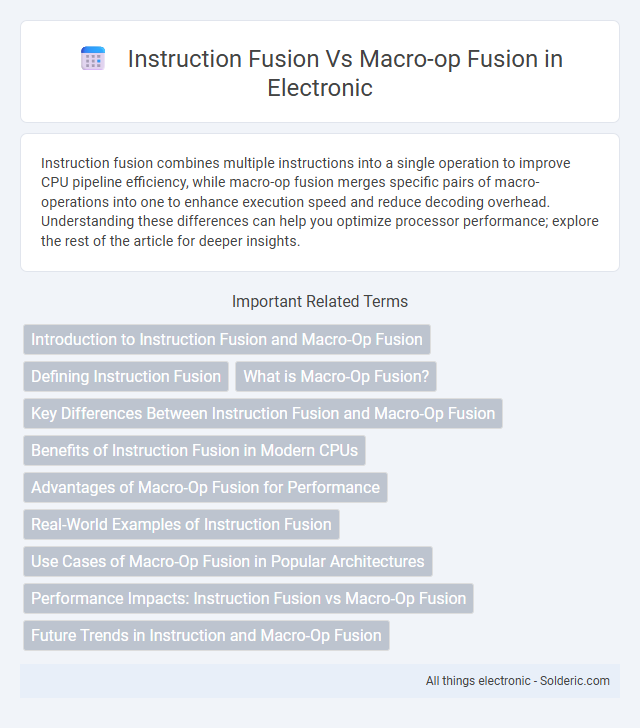Instruction fusion combines multiple instructions into a single operation to improve CPU pipeline efficiency, while macro-op fusion merges specific pairs of macro-operations into one to enhance execution speed and reduce decoding overhead. Understanding these differences can help you optimize processor performance; explore the rest of the article for deeper insights.
Comparison Table
| Feature | Instruction Fusion | Macro-op Fusion |
|---|---|---|
| Definition | Combines multiple simple instructions into a single internal operation. | Fuses multiple decoded micro-operations (macro-ops) into one to improve execution efficiency. |
| Scope | Operates at the instruction decode stage. | Works at the micro-op dispatch or issue stage. |
| Typical Usage | Common for simple instruction pairs like compare-and-branch. | Targets more complex instruction sequences like load-store pairs. |
| Performance Impact | Reduces decode bandwidth and improves pipeline throughput. | Decreases micro-op count, reducing execution latency and resource usage. |
| Example Architectures | Intel Sandy Bridge, Haswell (instruction fusion) | Intel Skylake, Ice Lake (macro-op fusion) |
| Implementation Complexity | Relatively simple, limited fusion patterns. | More complex, requires micro-op scheduler awareness. |
Introduction to Instruction Fusion and Macro-Op Fusion
Instruction fusion combines multiple machine instructions into a single operation to improve CPU pipeline efficiency and reduce execution latency. Macro-op fusion merges decoded micro-operations generated from complex instructions, optimizing instruction throughput by minimizing the number of micro-ops entering the pipeline. Understanding these technologies helps you evaluate CPU performance enhancements and their impact on instruction-level parallelism.
Defining Instruction Fusion
Instruction fusion is a microarchitectural optimization that combines two or more adjacent instructions into a single, more efficient micro-op, reducing pipeline length and execution latency. Unlike macro-op fusion, which operates at the decoder level to merge instruction pairs for simplified dispatch, instruction fusion occurs deeper in the processor's execution engine, enhancing throughput by minimizing resource usage. Understanding instruction fusion helps you optimize software performance by aligning code patterns to processor fusion capabilities.
What is Macro-Op Fusion?
Macro-Op Fusion is a CPU optimization technique that combines multiple micro-operations (micro-ops) derived from a single complex instruction into fewer micro-ops, improving processing efficiency and reducing pipeline latency. This fusion typically occurs in the decode stage of the pipeline, allowing the processor to execute simpler, fused micro-ops rather than multiple separate ones. Macro-Op Fusion is distinct from instruction fusion, which merges separate instructions, as it specifically targets combining micro-ops from a single complex instruction for streamlined execution.
Key Differences Between Instruction Fusion and Macro-Op Fusion
Instruction fusion combines individual machine instructions into a single operation at the decode stage, improving pipeline efficiency and reducing execution latency. Macro-op fusion merges multiple decoded micro-operations (macro-ops) into one fused macro-op to optimize execution units and minimize resource contention. Understanding these key differences helps you leverage processor optimizations for enhanced performance in software development and system tuning.
Benefits of Instruction Fusion in Modern CPUs
Instruction fusion enhances CPU efficiency by combining multiple simple instructions into a single complex micro-operation, reducing pipeline stages and execution latency. This process optimizes resource utilization and increases instruction throughput, leading to improved performance and energy efficiency. Your system benefits from faster processing speeds and lower power consumption, making instruction fusion crucial for modern CPU architectures.
Advantages of Macro-Op Fusion for Performance
Macro-op fusion enhances CPU performance by reducing the number of decoded instructions, which lowers pipeline pressure and improves instruction throughput. This process enables more efficient utilization of execution units by combining multiple micro-ops into a single macro-op, leading to fewer resources used and less power consumption. The consolidation also decreases branch misprediction penalties, resulting in faster instruction dispatch and overall improved execution efficiency.
Real-World Examples of Instruction Fusion
Instruction fusion combines multiple machine instructions into a single micro-op to enhance CPU pipeline efficiency, evident in Intel's Haswell and Skylake architectures where fused compare-and-branch instructions reduce execution stages. Macro-op fusion merges separate macro-ops, such as a compare followed by a jump, into one to improve instruction throughput, commonly utilized in modern x86 CPUs for optimizing conditional branches. Understanding these fusion techniques helps you optimize software performance by aligning code with processor capabilities.
Use Cases of Macro-Op Fusion in Popular Architectures
Macro-op fusion improves CPU efficiency by combining multiple micro-operations from a single instruction into one, reducing pipeline stages and power consumption in popular architectures such as Intel's Sandy Bridge and Haswell. It accelerates common instruction pairs like CMP followed by a Jcc (conditional jump), optimizing branch prediction and instruction decoding. This fusion technique enhances performance in compute-intensive applications, gaming, and real-time processing by streamlining execution in modern x86 microarchitectures.
Performance Impacts: Instruction Fusion vs Macro-Op Fusion
Instruction fusion reduces pipeline stages by combining simple instructions into a single micro-operation, enhancing performance by lowering decode overhead and improving instruction throughput. Macro-op fusion merges multiple macro-operations into a single micro-op, which optimizes execution efficiency and reduces resource contention across the processor pipeline. Your system's performance benefits from instruction fusion in faster instruction decoding, while macro-op fusion boosts overall execution by consolidating complex instruction sequences.
Future Trends in Instruction and Macro-Op Fusion
Future trends in instruction fusion and macro-op fusion emphasize increased efficiency in CPU pipeline optimization and power management. Enhanced fusion techniques aim to combine more complex instruction patterns dynamically, reducing execution latency and improving throughput in modern processors. Your computing performance could benefit from processors that leverage advanced fusion mechanisms to handle diverse workloads with optimized resource utilization.
instruction fusion vs macro-op fusion Infographic

 solderic.com
solderic.com